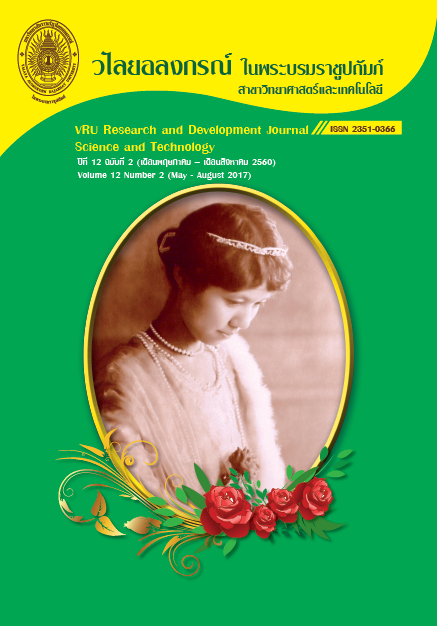ผลของสารสกัดดาวเรือง (Tagetes erecta L.) ในควบคุมหนอนผีเสื้อกินใบมะนาว Papilio demoleus Linnaeus (Lepidoptera: Papilionidae)
Main Article Content
Abstract
การทดสอบผลของสารสกัดจากดาวเรืองที่สกัดด้วยเอทานอล ในการเป็นสารยับยั้งการกิน สารฆ่าและสารยับยั้งการเจริญเติบโตของหนอนผีเสื้อกินใบมะนาววัย 4 โดยวิธีจุ่มใบพืช ที่ความเข้มข้น 0, 0.3125, 0.625, 0.125, 0.25 และ 5% (w/v) พบว่าสารสกัดดาวเรืองมีประสิทธิภาพในการเป็นสารยับยั้งการกิน สารฆ่าและสารยับยั้งการเจริญเติบโตของหนอนผีเสื้อกินใบมะนาว มีความแตกต่างกันอย่างมีนัยสำคัญที่ระดับความเชื่อมั่น 95% เมื่อเปรียบเทียบกับชุดควบคุม ที่ความเข้มข้น 5% มีประสิทธิภาพในการยับยั้งการกิน การฆ่าและการยับยั้งการเจริญเติบโตสูงสุด โดยการยับยั้งการกิน (AFI) ของหนอนสูงสุดเท่ากับ 51.89 และ 66.50% ในชั่วโมงที่ 24 และ 48 ชั่วโมง ตามลำดับ ในการเป็นสารฆ่าหนอนเท่ากับ 86.60 และ 100% ค่า LC50 มีค่าเท่ากับ 2.27 และ 1.14% ในชั่วโมงที่ 24 และ 48 ชั่วโมง ตามลำดับ นอกจากนี้ความเข้มข้น 0.3125% ระยะดักแด้มีเปอร์เซ็นต์การตาย 43.30% เมื่อเปรียบเทียบกับชุดควบคุมระยะดักแด้มีเปอร์เซ็นต์การตาย 3.33% ระยะเวลาในการพัฒนาเจริญเติบโตเป็นระยะดักแด้และตัวเต็มวัยใช้เวลาเฉลี่ย 7.33 + 0.47 และ 13.33 + 0.47 วัน ตามลำดับ ในขณะที่ชุดควบคุมระยะเวลาในการพัฒนาเจริญเติบโตเป็นระยะดักแด้และตัวเต็มวัยใช้เวลาเฉลี่ย 3.66 + 0.47 และ 6.66 + 0.47 ตัว ตามลำดับ
The anti-feedant, insecticidal and inhibiting growth activity of ethanol extracts from marigold extract were tested on the 4th instar larvae of Papilio demoleus Linnaeus. The leaf dipping method at various concentrations of marigold extract 0, 0.3125, 0.625, 0.125, 0.25 and 5% (w/v) were applied. The results found that the marigold extract at the concentration of 5% (w/v) was highly effective in the anti-feedant, insecticidal and inhibiting growth activity. The anti-feedant showed the value 51.89 and 66.50% at 24 and 48 hours, respectively. The insecticidal showed the value 86.6 and 100% and showed the LC50 of 2.27 and 1.14% at 24 and 48 hours, respectively. Besides, at the concentration of 0.3125% of marigold extract was 43.30% of mortality of pupa stage when compared with control was 3.33%. The time of development of pupa stage and adult stage were 7.33 + 0.47 and 13.33 + 0.47 days, respectively when compared with control were 3.66 + 0.47 and 6.66 + 0.47 days, respectively.
Downloads
Article Details
Copyright Notice
The copyright of research articles published in the VRU Research and Development Journal Science and Technology Journal belongs to the Research and Development Institute, Valaya Alongkorn Rajabhat University under the Royal Patronage. Reproduction of the content, in whole or in part, is prohibited without prior written permission from the university.
Responsibility
The content published in the VRU Research and Development Journal Science and Technology Journal is the sole responsibility of the author(s). The journal does not assume responsibility for errors arising from the printing process.
References
ธวัชชัย หยุบแก้ว. (2558). มะนาว..พืชแก้วิกฤติภัยแล้งและใช้น้ำน้อย. วิชาการปริทัศน์. 23(12): 5-8.
รัตนาภรณ พรหมศรัทธา, มัณฑนา มิลน และอารมณ แสงวนิชย์. (2543). การศึกษาองคประกอบทางเคมีของดาวเรือง. การประชุมทางวิชาการของมหาวิทยาลัยเกษตรศาสตรครั้งที่ 39.มหาวิทยาลัยเกษตรศาสตร์: กรุงเทพฯ. หน้า 406-409.
Abbott, W.S. (1925). A method for computing the effectiveness of an insecticide. Journal of Economic Entomology. 18: 265– 267.
Arivoli, S and S. Tennyson. (2013). Screening of plant extracts for oviposition activity against Spodoptera litura (Fab) (Lepidoptera: Noctuidae). International Journal of Fauna and Biological Studies. 1(1): 20-24.
Blaney, W.M., M.S.J. Simmonds., S.V. Evans and L.E. Fellows. (1984). The role of the secondary plant compound 2,5-dihydroxymethyl 3,4 dihydroxypyrrolidine as a feeding inhibitor for insects. Entomologia Experimentalis Et Applicata. 36: 209–216.
Dey, K.R., P. Choudhury and B.K. Dutta. (2013). Impact of pesticide use on the health of farmers: A study in Barak valley, Assam (India). Journal of Environmental Chemistry and Ecotoxicology. 5(10): 269-277.
Escoubas, P., Y. Fukushi, L. Lajide and J. Mizutani. (1992). A new method for fast isolation of insect antifeedant compounds from complex mixtures. Journal of Chemical Ecology. 18: 1819-1832.
Finney, D.J. (1971). Statistical method in biological assay (Second edition). Charles Griffin & Co. London. 668 p.
Isenring, R. (2010). Pesticides reduce biodiversity. Pesticides News. 88: 4-7.
Isman, M.B. (2000). Plant essential oils for pest and disease management. Crop Protection. 19: 603-608.
Mishra, M., K.K. Gupta and S. Kumar. (2015). Impact of the Stem Extract of Thevetia neriifolia on the Feeding Potential and Histological Architecture of the Midgut Epithelial Tissue of Early Fourth Instars of Helicoverpa armigera Hübner. International Journal of Insect Science. 7: 53–60.
Pena, J.E., A. Hunsberger and B. Schaffer. (2000). Citrus Leafminer (Lepidoptera:Gracillariidae) Density: Effect on Yield of ‘Tahiti’ Lime. Journal of Economic Entomology. 93(2): 374-379.
Phoofolo, M.W., S. Mabaleha and S.B. MekFbib. (2013). Laboratory assessment of insecticidal properties of Tagetes minuta crude extracts against Brevicoryne brassicae on cabbage. Journal of Entomology and Nematology. 5(6): 70-76.
Prakash, A., J. Rao and V. Nandagopal. (2008). Future of Botanical Pesticides in rice, wheat, pulses and vegetables pest management. Journal of Biopesticides. 1(2): 154–169.
Priyanka, D., T. Shalini and V.K. Navneet. (2013). A brief study on marigold (Tagetes species): a review. International Research Journal of Pharmacy. 4(1): 43-49.
Ray, D.P., P. Dureja and S. Walia. (2008). Evaluation of Marigold (Tagetes erecta L.) Flower Essential Oil for Antifeedant Activity against Spodoptera litura F. Pesticide Research Journal. 20(1): 10-12.
Rizwan-ul-haq, M., M.Y. Hu., M. Afzal., M.H. Bashir., L. Gong and J. Luo. (2010). Impact of Two Medicinal Plant Extracts on Glutathione S-Transferase Activity in the Body Tissues Spodoptera exigua (Lepidoptera: Noctuidae). Pakistan Journal of Botany. 42(6): 3971-3979.
Sarada, G., K Gopal., KT.V. Ramana., L.M. Lakshmi and T. Nagalakshmi. (2014). Citrus
Butterfly (Palilio demoleus Linnaeus) Biology and Management A Review.
Journal of Agriculture and Allied Sciences. 3(1): 17-25.
Sarwar, M and M. Salman. (2015). Insecticides Resistance in Insect Pests or Vectors and Development of Novel Strategies to Combat Its Evolution. International Journal of Bioinformatics and Biomedical Engineering. 1(3): 344-351.
Shareef, M.F., A.B.M Raza., M.Z. Majeed., K.S. Ahmed, W. Raza and H.F. Hussain. (2016). Effect of botanicals on the infestation of citrus leaf miner, Phyllocnistis citrella stainton. Journal of Entomology and Zoology Studies. 4(4): 1335-1340.
Tennant, P.F., D. Robinson., L. Fisher., S.M. Bennett., D. Hutton., P. Coates-Beckford and W.M. Laughlin. (2009). Diseases and Pests of Citrus (Citrus spp.). Tree and Forestry Science Biotechnology. 3(2): 81-107.


